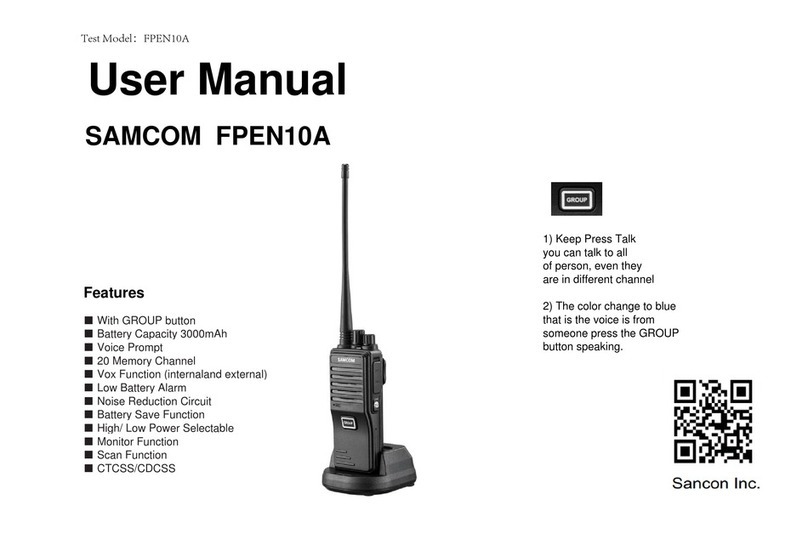Medical devices
Pacemaker
Advanced Medical Technology Association of the United States
proposes holding the handheld transceiver with pacemakers should
be kept the distance of at least 6 inches (15cm). These proposals
are consistent with the provisions by the U.S. Food and Drug
Administration.
With pacemakers should observe the following
items:
When the transceiver is turned on, the distance between the
pacemaker and the transceiver at least 6 inches (15cm);
Do not put the transceiver in a breast pocket;
Please use the pacemaker the other side of the ear to listen, to
minimize potential interference;
If you suspect transceiver interference with the pacemaker,
immediately turn off it.
Hearing Aids
Some transceivers may interfere with some hearing aids. When
there is such interference, you can consult the hearing aid
manufacturer to discuss alternatives.
Busy Channel Lockout
This feature can prevent interferences to other walkie-talkies in the
same channel. If the channel has been occupied, the press of the
PTT button will bring a continuous "beep" warning tone, while the
transceiver will return to the receive mode immediately. To stop the
warning tone, please release the PTT button. Dealers can set this
function turn on or off by programming software.
Low Battery Warning
Low battery warning happens at the time when the battery needs
charging or replacement. If the battery is low, the transceiver indicator
light turns red and blinks, and a beep sound can be heard every 5
seconds. At this time, please replace the battery.
Voice Operated Transmitting (VOX)
This feature is designed to trigger the transmitting of voice by voice
itself. Dealers can choose to turn on or off the VOX feature, and set
the sensitivity of VOX through programming. With this feature,
transmitting operation is launched by the voice you said without
having to press the PTT button. The transmitting operation stops as
soon as the end of the talk.
6
Other Medical Equipments
If you use other personal medical device, consult the device
manufacturer to determine whether these devices can effectively
shield radio frequency energy. Your doctor can provide you with
such help.
Safe Driving
Check your car seat using the transceiver the relevant laws and
regulations, and follow the regulations.
If you use the transceiver while driving, please
note the following:
Concentrate on driving, pay attention to the situation of the road.
If possible, try to use the walkie-talkie-free function operation.
If the provision of using the transceiver while driving prohibited,
please drive the car to the roadside stop, and then make a call.
Call function
Hold down the scan/call button for 2 seconds, the transceiver will
send out a specific sub-tone that your companion transceiver will ring
prompted a call.
Wireclone function
Connect the copy line, hold down the scan / call button to power
on the transceiver, when you see the status indicator turns orange,
release the scanning / call button. Then press the PTT key to copy
the data channel to another radio. During the replication, copy
transceiver status indicator is flashing red and copied transceiver
status indicator is flashing green. After replication complete, copy
transceiver status indicator turns orange. If replication error occurs,
the copy transceiver status indicator flashes orange.
23




























